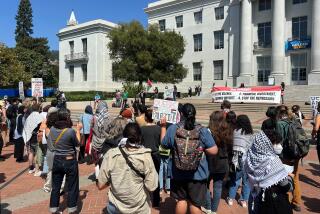UCSD Detours Plan for New Trolley Line : Faculty and Students Object to Idea of Tracks Cutting Across La Jolla Campus
- Share via
UC San Diego Chancellor Richard Atkinson on Thursday successfully detoured a plan to route the San Diego Trolley through the university’s La Jolla campus Thursday.
After listening to his protests, Metropolitan Transit Development Board directors agreed to take a second look at an alignment adopted Jan. 8, which would have run the trolley through the UCSD campus, west of Interstate 5.
Atkinson, appearing at Thursday’s transit meeting, stressed the almost total opposition of the university faculty and students to running the trolley line through the middle of the campus, and suggested that transit officials change to a route along the I-5 right-of-way or eastward along Regents Road.
Mayor Maureen O’Connor volunteered herself and Councilman Ed Struiksma, both transit board directors, for a joint UCSD-transit district task force to try to find a middle ground between the need to reduce traffic congestion in the La Jolla-University City area and the desire of UCSD officials to preserve the campus for pedestrians.
Atkinson argued that the trolley route should not invade the campus because UCSD will have its own internal people-mover program, a tram system that will circle the campus every seven minutes, providing access to all university areas. He stressed that the route approved by the transit board in January would pass too close to five major new buildings in the western part of the campus, creating vibrations that could endanger the accuracy of various sophisticated “one-of-a-kind” instruments in medical and scientific buildings.
He stressed that university officials were given only a two-day notice before the January MTDB meeting that the trolley route--which will probably not be built until the mid-1990s--was to be moved from a proposed I-5 alignment into the core of the western part of the campus. Atkinson argued that the university plans to move swiftly to develop its property east of I-5 in the next five to 10 years and that, by the year 2000, 40% of the campus activities will occur east of the freeway.
Atkinson presented the transit board members with copies of UCSD faculty and student senate resolutions condemning the adopted trolley route through the western portion of the campus. He noted that the Faculty Senate resolution was adopted 104-0, “the first time in my academic lifetime that the Faculty Senate has agreed unanimously on anything.”
The UCSD organizations also object strenuously to an easterly “spur” route through the campus, to link with University Towne Centre.
MTDB Chairman James Mills pointed out to Atkinson that both university and transit officials had failed to communicate their concerns to the opposition, and questioned whether the Faculty Senate was given information on both sides of the question before voting unanimously to oppose the adopted route. Mills agreed that further discussion might lead to a mutually acceptable routing through the north University City area.
MTDB planners have been working with the San Diego Assn. of Governments and with UCSD officials for nearly two years to determine the best route to extend the trolley lines northward from Mission Valley to Del Mar.
The segment is part of a 103-mile proposed system, including an eastern line from downtown San Diego to Santee; the current southern line to the border; a coastal line north to Oceanside, eventually linking to Escondido, and a Mission Valley line extending to San Diego Jack Murphy Stadium and eventually linking up with the eastern trolley line and serving San Diego State University.
Sandag transportation planners originally had recommended building the trolley line along the eastern edge of I-5 with a spur eastward to serve the Golden Triangle offices and shopping center area, chiefly because of the opposition from UCSD officials to a trolley route through the center of the campus.
More to Read
Sign up for Essential California
The most important California stories and recommendations in your inbox every morning.
You may occasionally receive promotional content from the Los Angeles Times.










